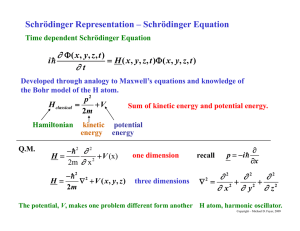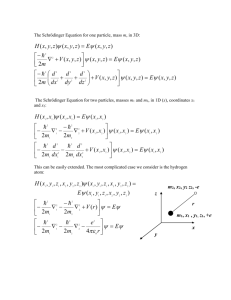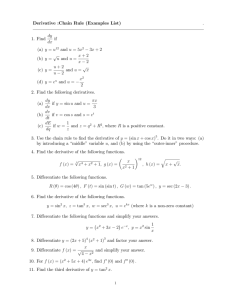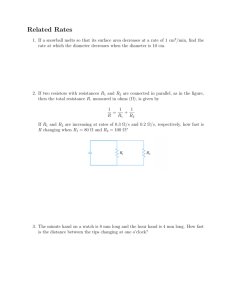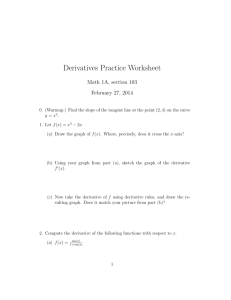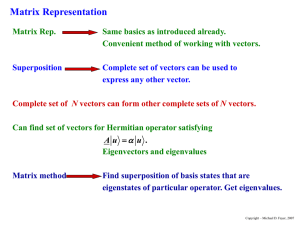Chapter05
advertisement
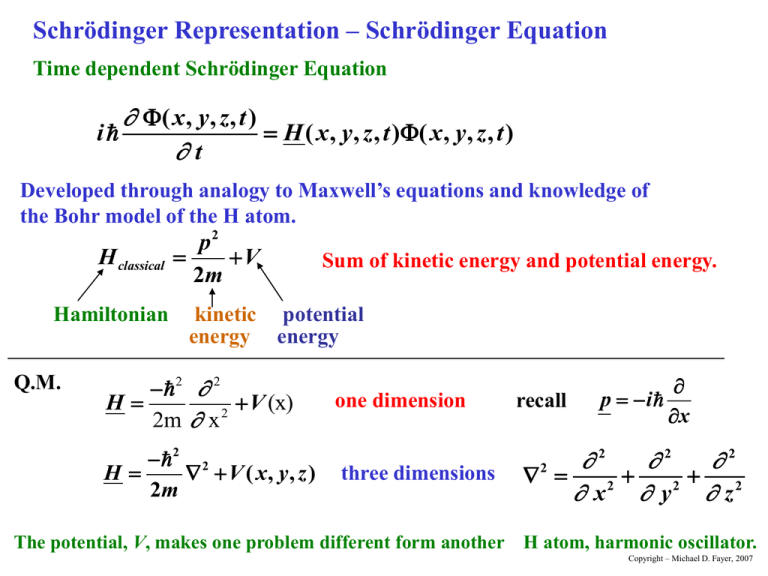
Schrödinger Representation – Schrödinger Equation Time dependent Schrödinger Equation i ( x , y , z , t ) H ( x , y , z , t )( x , y , z , t ) t Developed through analogy to Maxwell’s equations and knowledge of the Bohr model of the H atom. H classical Hamiltonian Q.M. p2 V 2m Sum of kinetic energy and potential energy. kinetic potential energy energy 2 2 H V (x) 2 2m x 2 2 H V ( x, y, z ) 2m p i x one dimension recall three dimensions 2 2 2 2 2 x y z2 2 The potential, V, makes one problem different form another H atom, harmonic oscillator. Copyright – Michael D. Fayer, 2007 Getting the Time Independent Schrödinger Equation ( x , y, z , t ) i wavefunction ( x , y , z , t ) H ( x , y, z , t )( x , y, z , t ) t If the energy is independent of time H ( x, y, z ) Try solution ( x , y , z , t ) ( x , y , z )F ( t ) product of spatial function and time function Then i ( x , y, z )F ( t ) H ( x , y, z ) ( x , y, z )F ( t ) t i ( x, y, z ) F ( t ) F ( t ) H ( x , y , z ) ( x , y , z ) t independent of t divide through by F independent of x, y, z Copyright – Michael D. Fayer, 2007 i dF ( t ) dt H ( x , y, z ) ( x , y, z ) F (t ) ( x, y, z ) depends only on t depends only on x, y, z Can only be true for any x, y, z, t if both sides equal a constant. Changing t on the left doesn’t change the value on the right. Changing x, y, z on right doesn’t change value on left. Equal constant i dF dt E H F Copyright – Michael D. Fayer, 2007 i dF dt E H F Both sides equal a constant, E. H ( x, y, z ) ( x, y, z ) E ( x, y, z ) Energy eigenvalue problem – time independent Schrödinger Equation H is energy operator. Operate on get back times a number. ’s are energy eigenkets; eigenfunctions; wavefunctions. E Energy Eigenvalues Observable values of energy Copyright – Michael D. Fayer, 2007 Time Dependent Equation (H time independent) i i dF ( t ) dt E F (t ) dF ( t ) E F (t ) dt dF ( t ) i E dt . F (t ) ln F iEt Integrate both sides C F (t ) e i E t / e i t Time dependent part of wavefunction for time independent Hamiltonian. Time dependent phase factor used in wave packet problem. Copyright – Michael D. Fayer, 2007 Total wavefunction E ( x, y, z , t ) E ( x, y, z )e i E t / E – energy (observable) that labels state. Normalization E E *E E d E* e i E t / E e i E t / d E* E d Total wavefunction is normalized if time independent part is normalized. Expectation value of time independent operator S. S S *E S E d E* e i E t / S E e i E t / d S does not depend on t, e i E t / can be brought to other side of S. S E* S E d Expectation value is time independent and depends only on the time independent part of the wavefunction. Copyright – Michael D. Fayer, 2007 Equation of motion of the Expectation Value in the Schrödinger Representation Expectation value of operator representing observable for state S A S AS example - momentum P S P S In Schrödinger representation, operators don’t change in time. Time dependence contained in wavefunction. Want Q.M. equivalent of time derivative of a classical dynamical variable. P P classical momentum goes over to momentum operator P P ? want Q.M. equivalent of time derivative t Definition: The time derivative of the operator A , i. e., A is defined to mean an operator whose expectation in any state S is the time derivative of the expectation of the operator A . Copyright – Michael D. Fayer, 2007 Want to find d A dt Use S A S t H S i S t time dependent Schrödinger equation. S A S S A S S A S t t t product rule time independent – derivative is zero S. t (operate to left) Use the complex conjugate of the Schrödinger equation S H i Then i S S H t i S H S t , and from the Schrödinger equation From Schrödinger eq. i S A S S H A S S AH S t From complex conjugate of Schrödinger eq. Copyright – Michael D. Fayer, 2007 Therefore d A dt This is the commutator of H A. i S H A AH S i A [ H , A] The operator representing the time derivative of an observable is i / times the commutator of H with the observable. Copyright – Michael D. Fayer, 2007 Solving the time independent Schrödinger equation The free particle momentum problem P P p P p ( x) 1 2 ei k x p k k p/ Free particle Hamiltonian – no potential – V = 0. 2 P H 2m Commutator of H with P 3 3 P P [P, H ] 0 2m 2m P and H commute P S PPP S 3 Simultaneous Eigenfunctions. Copyright – Michael D. Fayer, 2007 Free particle energy eigenvalue problem H P E P 2 H 2m x 2 2 Use momentum eigenkets. 2 1 ik x H P e 2 2m x 2 2 2 2 2m ( ik )2 e i k x k2 1 ik x e 2m 2 2 p2 P 2m 2 p Therefore, E 2m energy eigenvalues Energy same as classical result. Copyright – Michael D. Fayer, 2007 Particle in a One Dimensional Box V= V= V=0 Infinitely high, thick, impenetrable walls -b 0 b x Particle inside box. Can’t get out because of impenetrable walls. Classically E is continuous. E can be zero. One D racquet ball court. Q.M. xp /2 H E E can’t be zero. Energy eigenvalue problem Schrödinger Equation d 2 ( x ) +V ( x ) ( x ) E ( x ) 2 2m d x 2 V ( x) 0 x b V ( x) x b Copyright – Michael D. Fayer, 2007 x b For d 2 ( x ) E ( x) 2 2m d x 2 Want to solve differential Equation, but Solution must by physically acceptable. Born Condition on Wavefunction to make physically meaningful. 1. The wave function must be finite everywhere. 2. The wave function must be single valued. 3. The wave function must be continuous. 4. First derivative of wave function must be continuous. Copyright – Michael D. Fayer, 2007 d 2 ( x ) 2mE ( x) 2 2 dx Functions with this property Second derivative of a function equals a negative constant times the same function. sin and cos. d 2 sin(ax ) 2 a sin(ax ) 2 dx d 2 cos(ax ) a 2 cos(ax ) dx These are solutions provided a 2 2m E 2 Copyright – Michael D. Fayer, 2007 Solutions with any value of a don’t obey Born conditions. Well is infinitely deep. Particle has zero probability of being found outside the box. 0 = 0 for x b -b x 0 b Function as drawn discontinuous at x b To be an acceptable wavefunction sin and cos 0 at x b Copyright – Michael D. Fayer, 2007 will vanish at x b if n a an n is an integer 2b cos an x n 1, 3, 5... sin an x n 2, 4, 6... 0 –b b Integral number of half wavelengths in box. Zero at walls. Have two conditions for a2. 2 2 n 2mE 2 an 2 2 4b Solve for E. n2 2 2 n2 h2 Energy eigenvalues – energy levels, not continuous. En 2 8mb 8mL2 L = 2b – length of box. Copyright – Michael D. Fayer, 2007 n2 2 2 n2 h2 En 2 8mb 8mL2 Energy levels are quantized. Lowest energy not zero. 1 2 n x 1 n ( x ) cos 2b b 1 2 n x 1 n ( x ) sin 2b b x b n 1, 3,5 x b n 2,4,6 L = 2b – length of box. wavefunctions including normalization constants First few wavefunctions. Quantization forced by Born conditions (boundary conditions) n =3 0 n =2 0 Forth Born condition not met – first derivative not continuous. Physically unrealistic problem because the potential is discontinuous. n =1 0 -b 0 x b Like classical string – has “fundamental” and harmonics. Copyright – Michael D. Fayer, 2007 Particle in a Box Simple model of molecular energy levels. Anthracene L6 A L E2 S1 E E1 electrons – consider “free” in box of length L. Ignore all coulomb interactions. S0 m me 9 1031 kg 6 1010 m L6 A Calculate wavelength of absorption of light. Form particle in box energy level formula 3h2 E E2 E1 8mL2 E h h 6.6 1034 Js E / h 7.64 1014 Hz c / 393 nm blue-violet E 5.04 1019 J Experiment 400 nm Copyright – Michael D. Fayer, 2007 Anthracene particularly good agreement. Other molecules, naphthalene, benzene, agreement much worse. Important point Confine a particle with “size” of electron to box size of a molecule Get energy level separation, light absorption, in visible and UV. Molecular structure, realistic potential give accurate calculation, but It is the mass and size alone that set scale. Big molecules Small molecules absorb in red. absorb in UV. Copyright – Michael D. Fayer, 2007 Particle in a Finite Box – Tunneling and Ionization Box with finite walls. Time independent Schrödinger Eq. V(x)=V V(x)=V V(x)=0 -b 0 x d 2 ( x ) +V ( x ) ( x ) E ( x ) 2 2m d x 2 V ( x) 0 x b V ( x) V x b b Inside Box V = 0 d 2 ( x ) E ( x) 2 2m d x 2 d ( x) 2mE 2 ( x) 2 dx 2 Second derivative of function equals negative constant times same function. Solutions – sin and cos. Copyright – Michael D. Fayer, 2007 Solutions inside box ( x ) q1 sin 2mE 2 x or ( x ) q2 cos 2mE 2 x Outside Box d 2 ( x ) 2m ( E V ) ( x) 2 2 dx Two cases: Bound states, E < V Unbound states, E > V Bound States d 2 ( x ) 2m(V E ) ( x) 2 2 dx Second derivative of function equals positive constant times same function. Not oscillatory. Copyright – Michael D. Fayer, 2007 Try solutions d 2e ax 2 a x a e 2 dx exp ax Second derivative of function equals positive constant times same function. Then, solutions outside the box 1/ 2 ( x) e 2 m (V E ) x 2 x b Solutions must obey Born Conditions ( x ) can’t blow up as x Therefore, 1/ 2 ( x ) r1 e 2 m (V E ) x 2 xb 1/ 2 ( x ) r2 e 2 m (V E ) x 2 Outside box Inside box exp. decays oscillatory x b Copyright – Michael D. Fayer, 2007 Outside box Inside box 0 -b 0 x b exp. decays oscillatory The wavefunction and its first derivative continuous at walls – Born Conditions. Expanded view For a finite distance into the material finite probability of finding particle. x b Classically forbidden region V > E. 0 probability 0 Copyright – Michael D. Fayer, 2007 Tunneling - Qualitative Discussion Classically forbidden region. Wavefunction not zero at far side of wall. 0 Probability of finding particle small but finite outside box. X A particle placed inside of box with not enough energy to go over the wall can Tunnel Through the Wall. Formula derived in book mass = me E = 1000 cm-1 V = 2000 cm-1 e 2 d [2 m (V E )/ Wall thickness (d) 1 Å probability 0.68 2 1/2 ] 10 Å 0.02 Ratio probs - outside vs. inside edges of wall. 100 Å 3 10-17 Copyright – Michael D. Fayer, 2007 Chemical Reaction not enough energy to go over barrier Temperature dependence of some chemical reactions shows to much product at low T. E > kT . E reactants products q Decay of wavefunction in classically forbidden region for parabolic potential. d (2mV / e- tunneling parameter distance mass 2 1/ 2 ) light particles tunnel barrier height Copyright – Michael D. Fayer, 2007 Methyl Rotation H C H H Methyl groups rotate even at very low T. Radioactive Decay some probability outside nucleus repulsive Coulomb interaction nuclear attraction strong interaction Copyright – Michael D. Fayer, 2007 Unbound States and Ionization E large enough - ionization If E > V - unbound states V(x) = V bound states E<V -b b Inside the box (between -b and b) V=0 2mE ( x ) q1 sin x 2 ( x ) q2 cos d 2 ( x ) 2m ( E V ) ( x) 2 2 dx 2mE 2 x Solutions oscillatory Outside the box (x > |b|) E>V 2m( E V ) ( x ) s1 sin x 2 ( x ) s2 cos 2m ( E V ) 2 x Solutions oscillatory Copyright – Michael D. Fayer, 2007 unbound state -b b To solve (numerically) Wavefunction and first derivative equal at walls, for example at x = b q1 sin 2mE 2 b s1 sin 2m ( E V ) 2 b In limit E V (E V ) E q1 s1 Wavefunction has equal amplitude everywhere. Copyright – Michael D. Fayer, 2007 For E >> V ( x ) sin 2mE 2 x for all x As if there is no wall. Continuous range of energies - free particle Particle has been ionized. 2mE 2 2mp2 2 2m ( x ) sin k x 2 k2 2 k Free particle wavefunction Copyright – Michael D. Fayer, 2007 In real world potential barriers are finite. Tunneling Ionization Copyright – Michael D. Fayer, 2007
